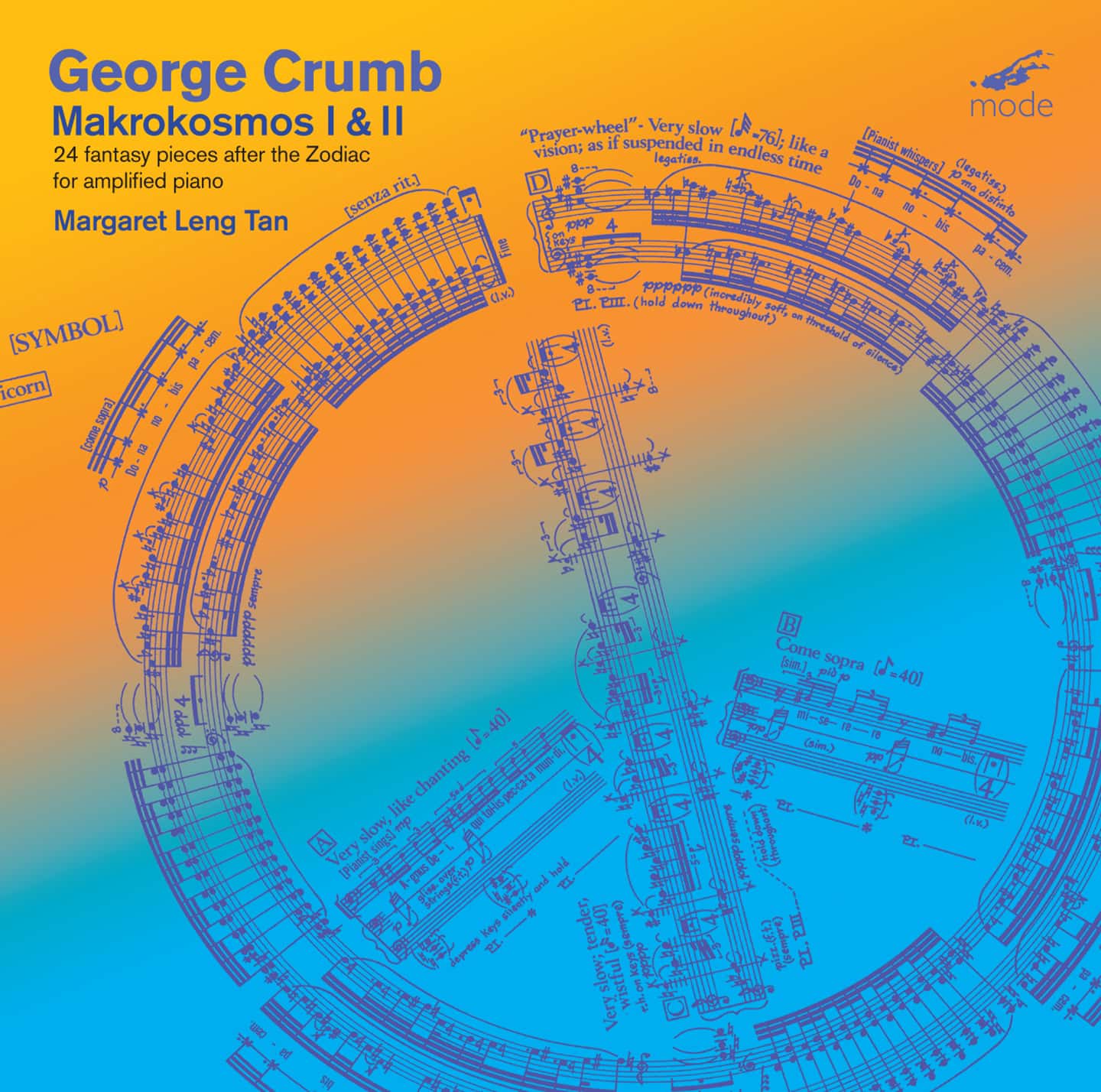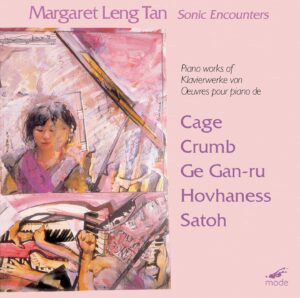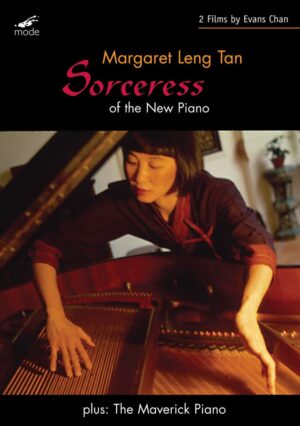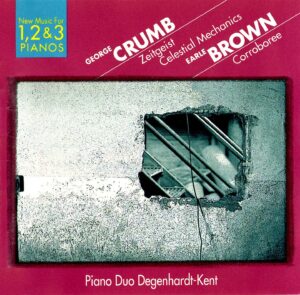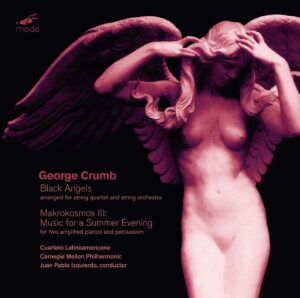Makrokosmos I & II for Solo Amplified Piano - CD
Previously released as a compact disc.
Margaret Leng Tan, piano
Volume I
Part One:
1. Primeval Sounds (Genesis I) Cancer (4:07)
G.R. Darkly mysterious
2. Proteus Pisces W.R.C. (1:16)
Very fast; whimsical, volatile
3. Pastorale (from the Kingdom of Atlantis, ca. 10,000 B.C.) Taurus J.B. (1:56)
Moderately, with incisive rhythm
4. Crucifixus [Symbol] Capricorn R.L.F. (2:55)
Darkly mysterious
Part Two:
5. The Phantom Gondolier Scorpio G.H.C. (2:49)
Eerily, with a sense of malignant evil
6. Night-Spell I Sagittarius A.W. (3:45)
Poised, expectantly
7. Music of Shadows (for Aeolian Harp) Libra P.Z. (2:09)
Gracefully, with elastic rhythm
8. The Magic Circle of Infinity (Moto perpetuo) [Symbol] Leo C.D. (2:04)
Joyously, like a cosmic clock-work; with mechanically precise rhythm
Part Three:
9. The Abyss of Time Virgo A.S. (2:41)
Dark, with sense of profound mystery
10. Spring-Fire Aires D.R.B. (1:38)
Prestissimo; breathlessly, with élan
11. Dream Images (Love-Death Music) Gemini F.G.L. (4:18)
Musingly, like the gentle caress of a faintly remembered music
12. Spiral Galaxy [Symbol] Aquarius B.W. (2:43)
Vast, lonely, timeless
Volume II
Part One:
13. Morning Music (Genesis II) Cancer J.DeG.W. (2:32)
Exuberantly, with primitive energy
14. The Mystic Chord Sagittarius R.M. (2:17)
Adagio molto; serene, desireless, like a Nirvana-trance
15. Rain-Death Variations Pisces F.C. (1:36)
Crystalline, with elegance
16. Twin Suns (Doppelgänger aus der Ewigkeit) [Symbol] Gemini E.A.C. II (3:09)
Majestic
Part Two:
17. Ghost-Nocturne: for the Druids of Stonehenge (Night-Spell II) Virgo A.B. (2:07)
Dark, fantasmic, subliminal
18. Gargoyles Taurus P.P. (1:20)
Marcia grottesca; savagely, with irony
19. Tora! Tora! Tora! (Cadenza Apocalittica) Scorpio L.K. (3:17)
Dramatic, with great intensity; violent, relentless
20. A Prophecy of Nostradamus [Symbol] Aries H.W. (1:57)
Stark, powerful; molto pesante
Part Three:
21. Cosmic Wind Libra S.B. (2:11)
Ghostly, shadowy, tremulous
22. Voices from “Corona Borealis” Aquarius E.M.C. (3:27)
Passacaglia: very slow, with majestic calm
23. Litany of the Galactic Bells Leo R.V. (2:33)
Jubilant; metallic. incisive, echoing
24. Agnus Dei [Symbol] Capricorn R.W. (4:13)
“Prayer-wheel” – Very slow; like a vision; as if suspended in endless time
- Crumb’s Makrokosmos I & II were written to expand the world of color and sonic possibilities which a single piano and pianist could create
- In addition to playing the keyboard, the pianist is required to strum and pluck the strings; apply glass tumblers and paper to the piano interior; as well as chant, whistle and whisper – to create a work at times pastoral, mysterious, jubilant, dark, otherworldly and terrifying
- Composer supervised recordings
- Both Books presented in their entirety on one disc
- Modeled after the Zodiac, each Book consists of 12 short movements
- Pianist Margaret Leng-Tan – considered the leading exponent of “extended” piano techniques – is at her best with this music
- Mr. Crumb and Ms. Tan worked closely on the preparation of these works for the recording
- The hi-definition 96-khz/24-bit recording reveals all of the spectacular qualities of the music
SPECIAL DVD FEATURES:
- The complete performance filmed by Hong Kong director Evans Chan
- Interview of George Crumb & Margaret Leng-Tan by Don Gillespie, long-time friend and Crumb’s publisher
- Recorded in 5.1 Surround Sound plus alternate PCM-stereo track
- Full 96-khz/24-bit audio
- Dolby Digital and additional DTS audio
- Subtitles: French, German, Spanish
George Crumb on the DVD version:
I want to express my appreciation to Mr. Evans Chan for his marvelous DVD version of my Makrokosmos I & II which was recently released by Mode Records. Mr. Chan totally captured the intensity and drama of Margaret Leng Tan’s beautiful performance of my most challenging piano music. He employed unusual visual angles and imaginative special film effects to create an incredibly potent blending of the sonic and the visual. The record industry is poised at the very first beginning of a totally new concept for delivering new music to the public and I feel that Mr. Chan’s pioneering efforts in the field of DVD recordings will prove immensely influential in its further development. I want to also congratulate him on his film ’Sorceress of the New Piano,’ which is a thoughtful and sensitive documentation of the multifaceted career of pianist Leng Tan. Here again the visual elements support so eloquently the musical excerpts (including music by John Cage and other composers.) I extend my very best wishes for Mr. Chan’s further essays in this exciting arena and wish him continued success.
’ George Crumb, June 2, 2005, Media, Pennsylvania
Language : English with optional French, German, and Spanish subtitles.
Reviews
George Crumb
Makrokosmos Books 1 and 2
Mode 142
For anyone reading this who has yet to make the switch from VHS, there are no more excuses to live in the digital dark ages. For less than the retail price of this George Crumb DVD, you can actually buy a DVD player. Need proof? Just look here. Tangent: Can you believe the editor of this webzine just bought his first DVD player just two months ago? Even worse, it’s still sitting in the box waiting to be hooked-up. Maybe this Crumb video can be the motivating carrot that remedies the situation.
Thanks to Mode Records, new music fans already on the DVD bandwagon can start building a new subsection to their ever-growing AV collection, with titles by Roger Reynolds, Elliott Carter, John Cage, and Morton Subotnick. Just think how well they’ll fit next to those sexy Criterion Collection titles that you splurged on awhile back. But hey, qualms about overspending will evaporate from your mind while you bliss-out horizontally, listening to Morton Feldman’s second string quartet – all six hours of it – without the hassle of actually having to get up off your butt and swap CDs. Ah, life is much sweeter in DVD Land. Anyway, back to that George Crumb disc.
Besides all the features we’ve come to expect – options between DTS 24-bit 5.1 surround sound or 96khz/24-bit PCM stereo mix – experiencing Makrokosmos on this medium is very different from the concert-going experience. While the DVD vividly captures the sonic nuances of the concert hall, our eyes get a special play-by-play perspective. Filmmaker Evans Chan gives us shots of the gadgets Margaret Leng Tan uses on the piano strings, with close-ups of her hands, peeks over her shoulder, and bird’s eye views inside the piano. We don’t even need to crane our neck, just sit back on the couch. Bonus features include a 45-minute interview with Tan, Crumb, and his publisher Don Gillespie that provides some interesting insights, as well as a slideshow of Crumb’s original score sketches. Oh yeah, I almost forgot to mention the parallel audio-only release on CD. Why? Yes, it’s $4 cheaper. But I’d suggest a Netflix membership instead. By the way, the Crumb video is currently in my Netflix queue so I can watch it all again.
’ Randy Nordschow, SoundTracks: New Music Box, Issue 70 – Vol.6,
No.10, February 2005
George Crumb
Makrokosmos Books 1 and 2
Mode 142 (CD & DVD)
’Makrokosmos’, George Crumb’s ’24 fantasy pieces after the Zodiac’ – the homage to Schumann is clear – is, as Steven Bruns notes in his accompanying essay, performed quite frequently these days. And understandably so, as they’re eminently accessible, quotations of Beethoven and Chopin and poetic extra-musical programme notwithstanding, using a musical language sufficiently close to the composer’s role models – Bartók, Debussy, Messiaen – so as not to send uninitiated concertgoers screaming for emergency exits. Margaret Leng Tan performs the two twelve-movement cycles (each of which is subdivided into three groups of four pieces, each piece dedicated to someone born under the corresponding sign of the Zodiac) with exemplary precision. Even the ’Cadenza Apocalittica’ in Book II, with its lusty cries of ’Tora! Tora! Tora!’ and the Dies Irae doodles of the ensuing ’Prophecy of Nostradamus’, which can all too easily come off as bombastic and over the top, work remarkably well. Alex Nowitz’s wobbly theremin-like whistling (what? couldn’t Maggie handle that herself?) is a bit hard to take though, and the whispered Latin plus whole-tone-overload of the closing ’Agnus Dei’ rather trite, but it’s too easy to be blasé and snipe at Crumb. His meticulous sketches are proof that an approach to set theory as rigorous and uncompromising as Babbitt’s can coexist perfectly well with a deep affection for the unashamedly tonal and heartfelt romanticism of bygone days.
’ Dan Warbuton, www.paristransatlantic.com, June 2005
George Crumb
Makrokosmos Books 1 and 2
24 fantasy pieces after the Zodiac for amplified piano
Margaret Leng Tan [amplified piano] – Alex Nowitz [whistling]
Mode 142 [also available on DVD]
George Crumb wrote Makrokosmos in 1972 and 1973. These pieces constitute a massive and detailed exploration of the sounding possibilities of the piano. In one of his jotted-down notes Crumb says that his intention was to write ’an all-inclusive technical work for piano [using] all conceivable techniques’. This may seem a mighty task, but solely the honest intention of achieving something like that is bound to reach far, and far he has reached.
The manner of going about his chore reminds one of earlier attempts at writing full-fledged piano works – which also succeeded brilliantly, in their time – for example Johan Sebastian Bach’s Das Wohltemperierte Klavier, Frédéric Chopin’s Etudes & Preludes, Franz Liszt’s Trancendental Etudes, Dmitry Shostakovich’s Preludes & Fugues etcetera. Naturally, Crumb’s attempt is a modernistic one, using amplification and all sorts of performance methods that belong in a new era, an era of John Cage and Karlheinz Stockhausen.
The apparent ease of the flow of events in Makrokosmos may persuade one of an improvisational approach, but this is belied by the comprehensive sketches, with planning of the over-arching intent as well as the minute details.
In George Crumb’s Makrokosmos, the two sections are divided into three parts each, themselves sectioned into four parts that are to be played without interruption. Crumb has designed the last of the four parts of the three divisions of the two sections as a symbol, thus in Volume 1 presenting piece number 4 as a cross, number 8 as circle and number 12 as a spiral.
As can be viewed above, Crumb also had an affinity for fantasy-evoking titles! Some of these do remind me not so little of Terry Riley’s habit of giving his pieces beautiful and thought-provoking titles, like on his album Harp of New Albion (piano in just intonation) and Salome Dances for Peace (String Quartet).
Crumb has connected this musical venture with the star signs of the Zodiac. I suppose most of us thereby associate to Stockhausen and his rightly famous Tierkreis, which has been recorded innumerable times in different instrumentations, starting with Stockhausen’s original concept for music boxes – which can still be ordered from Stockhausen-Verlag! Crumb’s Zodiac adventure as presented here has also been the focus of many a recording!
Crumb has exemplified the characters of the Zodiac with the initials of specified persons born under those signs, like Lorca and Brahms, to mention a couple. Crumb composed Volume I in memory of Béla Bartók and Volume II in memory of Gustav Mahler. As the booklet text by Steven Bruns (which to a high degree constitutes the source for these comments) states, one of the more important aspects of Makrokosmos is the exploration of timbres, innumerable variations on nuances of timbres. This is a true listening adventure for the clean-eared! Of course, many un-orthodox playing practices are exercised by the brilliant pianist Margaret Leng Tan, like plucking strings inside the piano, playing glissandi across strings, sliding a scrape along a string and so forth – and the truly extraneous sound appears in whistles and vocal utterances…This reveals a peculiar, childish, humoristic whim, not unlike the counting and whistling in some Stockhausen pieces, or the bird whistles in some Cage works.
The Cage analogy is reinforced by Crumb’s insertion of objects between the strings, thus preparing the piano. However, these objects do not, as with Cage, stay put during performance, but are inserted and removed by the performer during playing.
Some of Crumb’s indications go far beyond what is traditional in musical scores, exactly pointing out what he is after: ’incisive, clear; serene, hauntingly; echoing; languidly, as from afar; very slow; like chanting; tender; wistful; like a vision; as if suspended in endless time.’
From a listener’s viewpoint – which viewpoint can be better concerning music! – this work is a deep adventure through sound, through a wondrous display of light and space and timbres, seemingly everlasting, eternally emitting from some kind of core of creativity and ingenuity which is the origin and true home of being.
What better way to start a work of music than with a piece entitled Primeval Sounds? Anyway, that is, of course, how Crumb begins Makrokosmos, in deep murmurs, slowly turning out there in the darknessâ¦like time rustling in eternity – but then; an explosion of sharp incisions clustered and tight – followed by those characteristic bamboo-sounding Cage-type preparationsâ¦until the sound grows into majestic proportions, swelling over the topography like overwhelming thoughts blown out of proportions by anxietyâ¦but then slowly sinking back into calmer, more restrained sections, only to swell again, yes, like slow, relentless and anonymous waves of darkness through the music and the emotions.
Proteus is quite different; fast, rippling beads of tones, ebony and ivory necklaces, glittering and shining ’round the neck of someone beautiful and desirable! Yes, a long neck, a proud look, a fantastic hairdo! This music is new and old; a remembrance of past eras in this new rippling of fast moving fingers up and down the keyboard! Ah, it’s so short – and then gone…A glimpse, barely a glimpse…
Pastorale (from the Kingdom of Atlantis) is rinsed romanticism, somehow – a very short, beautiful pianistic bagatelle: a little child jumping about in the pasture, golden locks in golden sunlight – a serious playfulness…
Crucifixus fetches its breath way down in La Monte Youngish realms (Well-Tuned Piano dark spots!) – but with insertions of preparations…and then, without warning; a violently close vocal exclamation, again Stockhausenesque, like his ’Salve Satanelli’ – but here: Christe! The music moves in slow breaths, hovering over the topography like ominous thunderclouds.
Yes, and this was just part 1 of Volume 1, and the rest of the set is just as varied; madly changing appearance, in a hall of mirrors of timbres and whimsical ideas, carefully executed by Margaret Leng Tan.
The Phantom Gondolier of part 2 of Volume 1 amounts to an intensive display of alternative ringing and rustling piano practices and the added pleasure (?) of Leng Tan’s moaning aaahs…
This marvelous playing doesn’t end until the music is played through, and then it remains in your head and mind for a long while, even coloring your dreams (the reviewer’s experience!)
The music is exciting, the playing is marvelous – Mode has produced another great disc.
And please meet Mr. Chopin on track 11!
’ Ingvar Loco Nordin, Sonoloco Record Reviews, December 2004
George Crumb
Makrokosmos Books 1 and 2
Mode 142
RECITAL REVIEW: When the Keyboard Is Merely an Option
You need much more than excellent technique to perform George Crumb’s ’Makrokosmos,’’ 24 fantasy pieces for amplified piano in two volumes, written in 1972-73. As the pianist Margaret Leng Tan demonstrated on Saturday night at Zankel Hall, you must also be a physically flexible and focused actor.
These fantasy-pieces with their evocative titles (like ’’The Phantom Gondolier’’ and ’Ghost-Nocturne for the Druids of Stonehenge’’) are complex works that broke new ground in the exploration of piano sonorities. But producing the unearthly and exotic sounds involves much more than simply playing the piano.
Ms. Tan spent much time leaning into the piano to pluck and scrape the strings, sometime with thimbles on her fingers, sometimes with a percussionist’s wire brush. In one work she used a glass tumbler to glide up and down the depressed strings to produce distant banshee cries or whistles, all of which were subjected to discreet amplification that prolonged and bent the tones. When some plucked string effect came off just right, Ms. Tan would thrust her hands into the air, her fingers spread, like a sorceress pleased with some new spice she had added to a gurgling brew. And in several pieces, while playing and scraping, Ms. Tan also had to sing and shout.
But most of ’Makrokosmos’ involves playing the piano in the traditional way, on the keyboard and with the fingers, which Ms. Tan did impressively, revealing a rich variety of touch and shadings as well as formidable technique during the music’s brilliant passages. On the surface many of these pieces can seem merely like timeless, amorphous essays in sound. The best ones are those in which the content of the music — the astringent harmonies, the skittish atonal flights, the crisscrossing contrapuntal lines — engage the brain as well as the ear. The few times Mr. Crumb quotes passages of familiar music, like the famous tune from Chopin’s Fantasie-Impromptu, an element of sentimental nostalgia intrudes. Still, it was impossible not to respond to Ms. Tan’s intense involvement with this visionary music.
’ Anthony Tommasini, The New York Times
The Arts/Cultural Desk, November 24, 2004
Wednesday, Late Edition – Final, Section E, Column 4, Page 16
George Crumb Makrokosmos
Margaret Leng Tan (prepared piano)
mode records CD 142
Out of stock for a long time, Margaret Leng Tan’s interpretation of Crumb’s ’Makrokosmos I & II’ has been reissued on CD. The DVD version should be available again in several months.
The music of George Crumb is certainly being celebrated this year to mark his 80th birthday. And Mode Records have re-issued a recording of both books of Makrokosmos, performed by Margaret Leng Tan, originally released in 2004 for his 75th birthday.
Crumb’s incorporation of the inside of the piano into his compositions began in 1962 with Five Pieces for Piano, commissioned and first performed by David Burge. Makrokosmos I followed in 1972 (premiered by Burge in 1973) and Makrokosmos II in 1973 (premiered in 1974 by Robert Miller). Crumb acknowledges the influence of Bartok’s Mikrokosmos (in six volumes) and Debussy’s Preludes (two books of twelve pieces) – each of the two books of Makrokosmos consists of twelve pieces, grouped into 3 parts of 4 pieces each. Extra-musical influences are offered in the designation of a sign of the Zodiac to each piece as well as a descriptive title. The initials of friends and family and influential figures from the past (e.g. Brahms, Lorca) are appended to the end of each piece and the fourth of each part of four pieces has a visual ’Symbol’ incorporating the notation to mark this structure, as well as providing Crumb himself with the opportunity to follow what could be a whim (e.g. the fourth piece in Volume II, ’Twin Suns’ is two circles of notation, and ’Crucifixus’ of Volume I is in the shape of a cross. Indeed ’Agnus Dei’, the final piece of Volume II is in the shape of the CND sign). So there is plenty of extra-musical material to trigger the pianist’s imagination and interpretation as well as the notation itself.
In an interview with Robert Shuffett (Peters Corp.1986)* Crumb answers two particular questions about his notation:
RS: Your calligraphy and careful notation have occasioned much commentary over the years. Would you comment on notation in general?
GC: I endeavour to make my own notation as simple and conventional as possible, since I want to communicate clearly and economically all the necessary information to the performer. If a score is a ’book of seven seals,’ then the composer is working against his own best interests. Of course notation can also be imaginative and provocative – I feel that all good music looks beautiful on the page.
RS: One visually striking aspect of your scores would be your ’symbolic notations’ – those representations of spirals, circular shapes, and so forth.
GC: Every composer should be permitted an occasional flight of whimsy!
The extended sound-world of the piano called upon in order to perform Makrokosmos includes techniques such as glissandi on the strings, production of harmonics, percussion on crossbeams and the soundboard, pizzicato, the use of a wire brush, the use of a light metal chain, some paper to produce a metallic buzz, thimbles, glass tumblers, arm clusters as well as detailed use of the sustaining and sostenuto pedals, particularly in sustaining groups of notes silently and activating those particular notes through strumming or invoking an eerie resonance at the bottom of the piano. Added to these techniques are various vocal effects such as whistling (warbling and theremin-like), shouting, whispering and moaning to further extend the sound-world.
What is particularly remarkable though about Crumb’s use of the piano and the harmonic structures of his compositions, is the resultant, almost orchestral resonance of the piano. The extended techniques are not the only reason for this heightened resonance and reverberance. The extremely detailed dynamics and large dynamic range as well as the finely gauged pauses that are written into the music give the piano time to ’breathe’ and for the harmonies and sounds to establish themselves, in their decaying resonance.
What Margaret Leng Tan achieves particularly well in her performance is the shading of the softer dynamics from p to ppp and she really draws the listener into the melodic shapes and layering of texture in this dynamic range. On the other hand, though her loud playing is very powerful and with a roundness and fullness of sound, some of the loud staccato passages could benefit from an even more incisive attack. Her incorporation of the extended techniques into the keyboard music is excellent – in particular her use of the thimbles (’Phantom Gondolier’) and glass tumblers (’Ghost Nocturne’) produce wonderful metallic sounds and spectral bending of the pitches, respectively. Her vocal contributions of words and eerie moanings are reasonably well judged and dramatic, where called for.
I wonder why she didn’t whistle? In ’Voices from the ‘Corona Borealis’’ because Leng Tan herself is not performing the whistled part, the two parts feel slightly less integrated in achieving the Passacaglia: very slow, with majestic calm performance instruction. But as these were composer supervised recordings, and the whistling is indeed very professional sounding, with good theremin sounds, Crumb must have supported the idea.
In this recording Margaret Leng Tan, through her virtuosic combining of playing inside and outside the piano, certainly makes the listener aware not just of isolated extended techniques, but of the whole sound-world and structure of Crumb’s fantasy pieces.
— Mary Dullea, www.musicalpointers.co.uk

